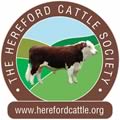 |
|||||||||
|
|||||||||||||||||||
|
|
European Conference Reports Surge in Demand for Hereford Beef 2010-07-01 A world-wide resurgence in the Hereford breed came into sharp focus at the European Hereford Conference, held in the UK last week (28 June).
Unprecedented demand for Hereford cattle in many parts of the world was not only considered to be excellent news for the Breed and its British breeders, but was also a reflection of a growing appreciation of taste and ‘eating quality’, which were increasingly lacking in ‘commodity beef’. Nowhere did this message come more strongly than from Jan Wills, Secretary General of the World Hereford Council who said that in her native New Zealand, the Hereford breed had recently been awarded best retail brand in the prestigious ‘Steak of Origin’ awards, while a leading abattoir had just begun paying a premium price for Hereford pure and cross-bred beef. This reflected similar schemes in the UK, where quality retailers such as Waitrose were already rewarding Hereford breeding with better prices. But Hereford breeders had no room for complacency and must adapt to changing market demands, said keynote speaker, Marcia Dutra de Barcellos, Associate Professor in marketing and business strategy from Brazilian University, Rio Grande do Sul. “Demand for quality beef is immense, and there is still a lot of room for growth,” she said. “And in my opinion, there’s a lot of space for the Hereford breed.” But coining the phrase, ‘survival of the most marketable’, she said that producers had to innovate and adapt to changing consumer demands with both their product and its marketing. They were competing in a rapidly changing market place in which convenience products were often based on poultry, with which they must compete head-on.
“There’s a huge place for innovation and the beef industry can do much more,” she said. Citing the example of online sales, she said: “You can buy Hereford steak on the internet, but to do that, you really have to trust your product so you must have consistent quality.” Suggesting the way forward was through co-operation at every stage, she said producers had to adopt a ‘chain mentality’ and form ‘alignments of interest’. Robin Irvine from County Armagh, Chairman of the UK’s Hereford Cattle Society and architect of the conference theme ‘Building the Hereford Brand’, said the Society’s own innovative ‘Superior Carcase Sire Scheme’ was a step in this direction. Aimed at commercial and pedigree breeders, he said these represented the first step in a complex food chain and were now being offered a cash incentive by the Society to use sires which could deliver improved quality to each link of this chain. Launched earlier this year, the scheme offers producers of pure, or cross-bred Hereford calves £5 per calf, up to a maximum of £500. The offer was open to the progeny of designated high performance sires with good Estimated Breeding Values (EBVs) for Retail Beef Yield (RBY), Eye Muscle Area (EMA) and Terminal Sire Index (TSI). “This is an investment by our Society and is intended to highlight the real potential of high performance Hereford-sired progeny,” said Mr Irvine. “We are pleased that, at three of the four Hereford Society events held this spring, ‘Superior Carcase Sires’ have taken the top prices and have also been judged Champions or Class Winners.” With a further performance benefit also conferred on any herd using high EBV sires, he said that independent EBLEX estimates were that a 50 cow suckler herd could benefit to the tune of £1,500 to £2,000 per annum through the better performance to be gained from using high, over average genetic merit sires.
|
||||||||||||||||||

|
|
||||||||||||||||||
| home | agri-services | pedigree
pen | news | dairy | beef | machinery property | organisations | site map |
|||||||||||||||||||


